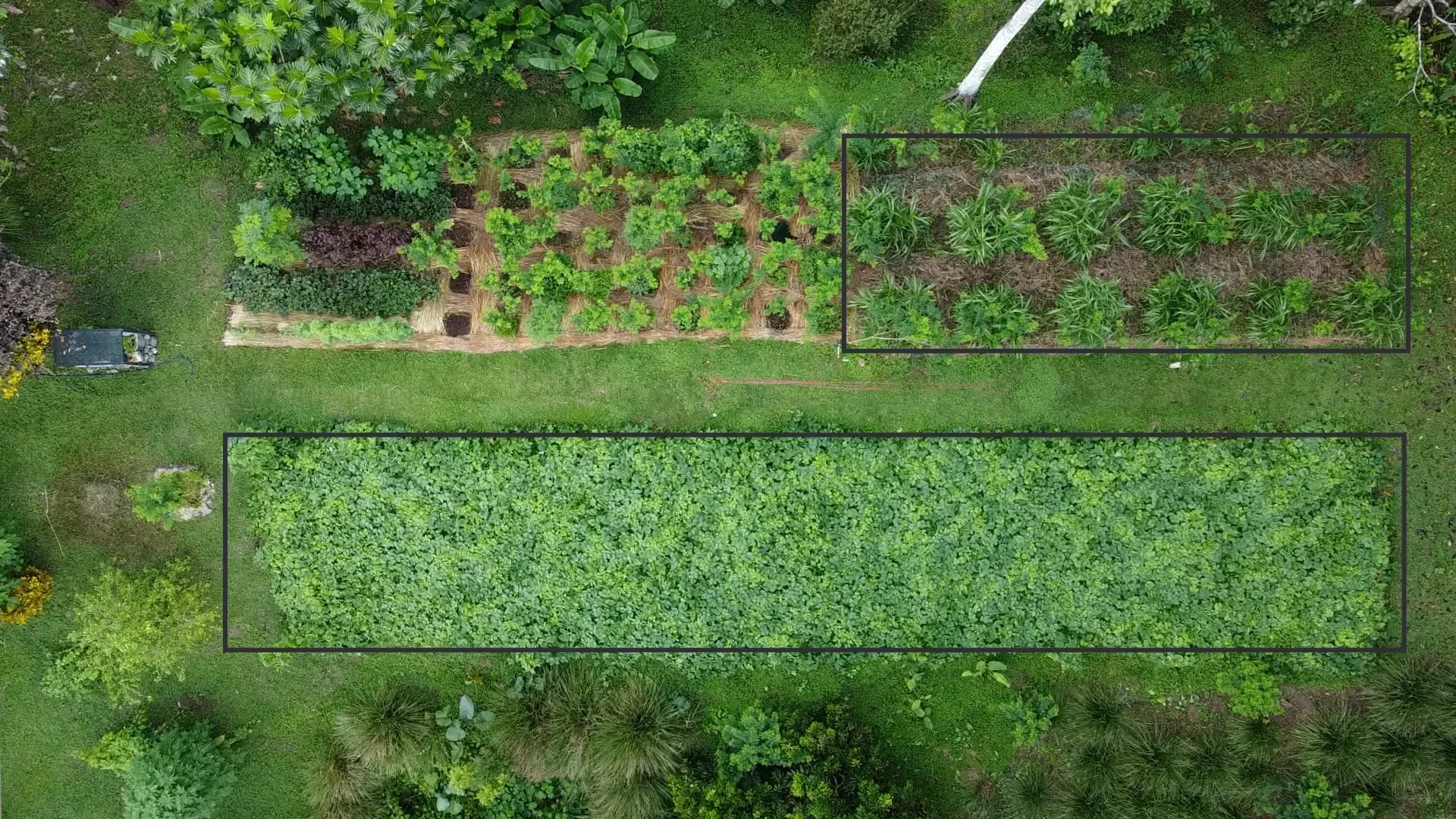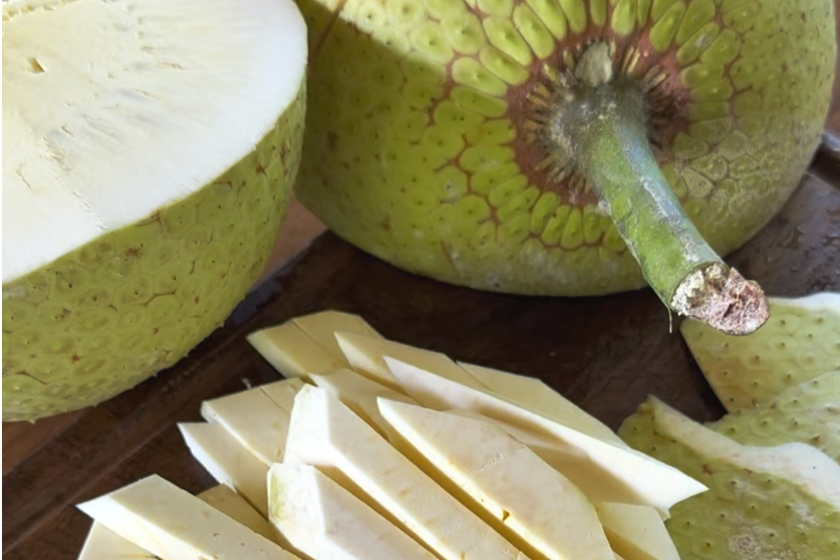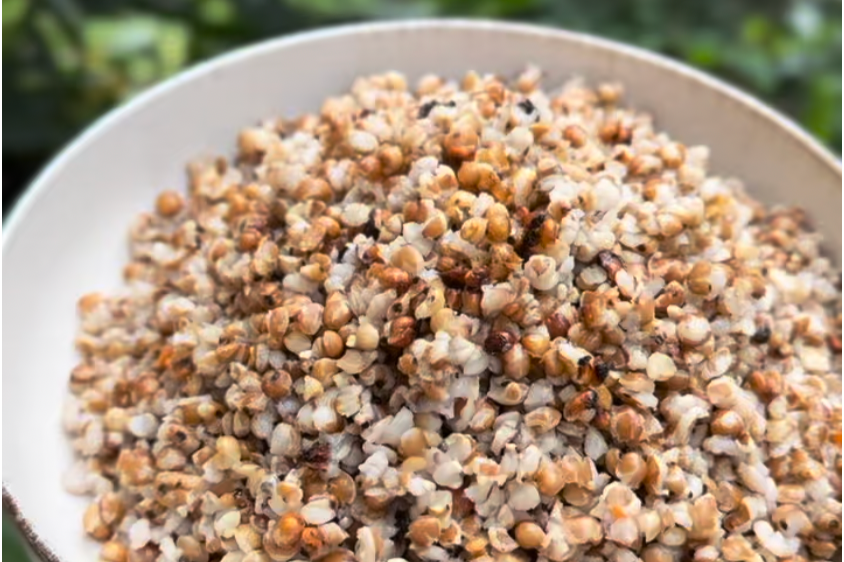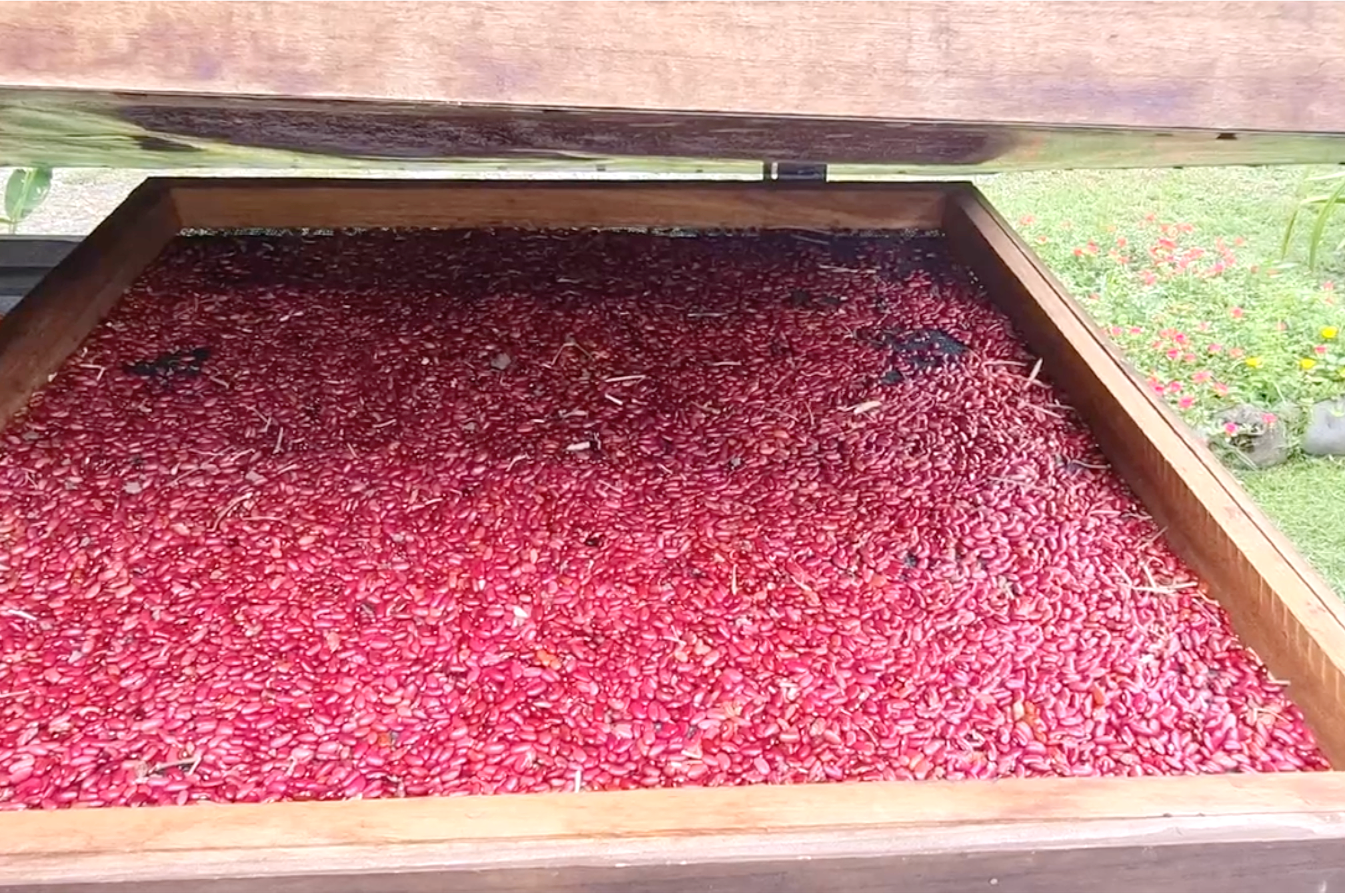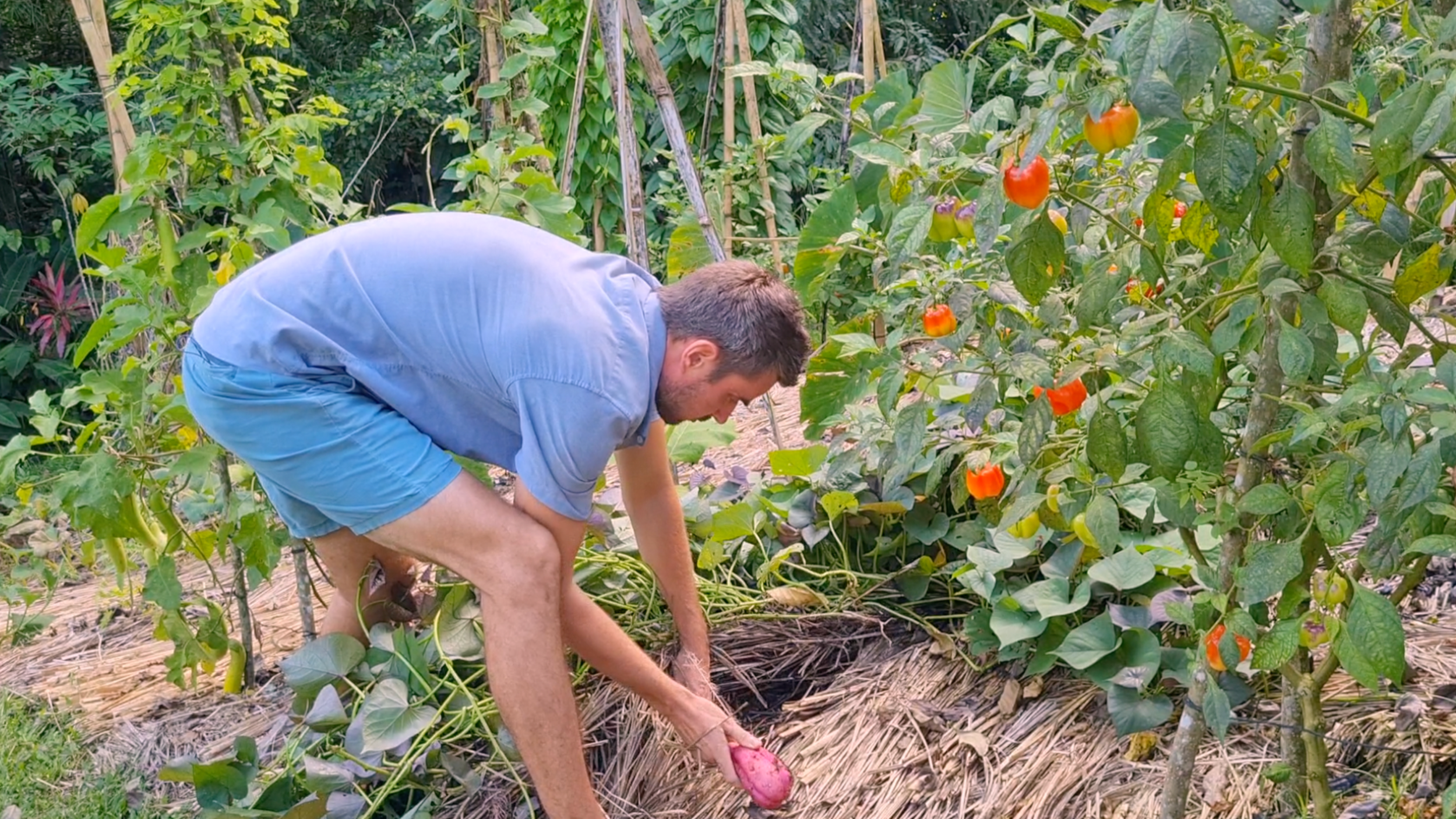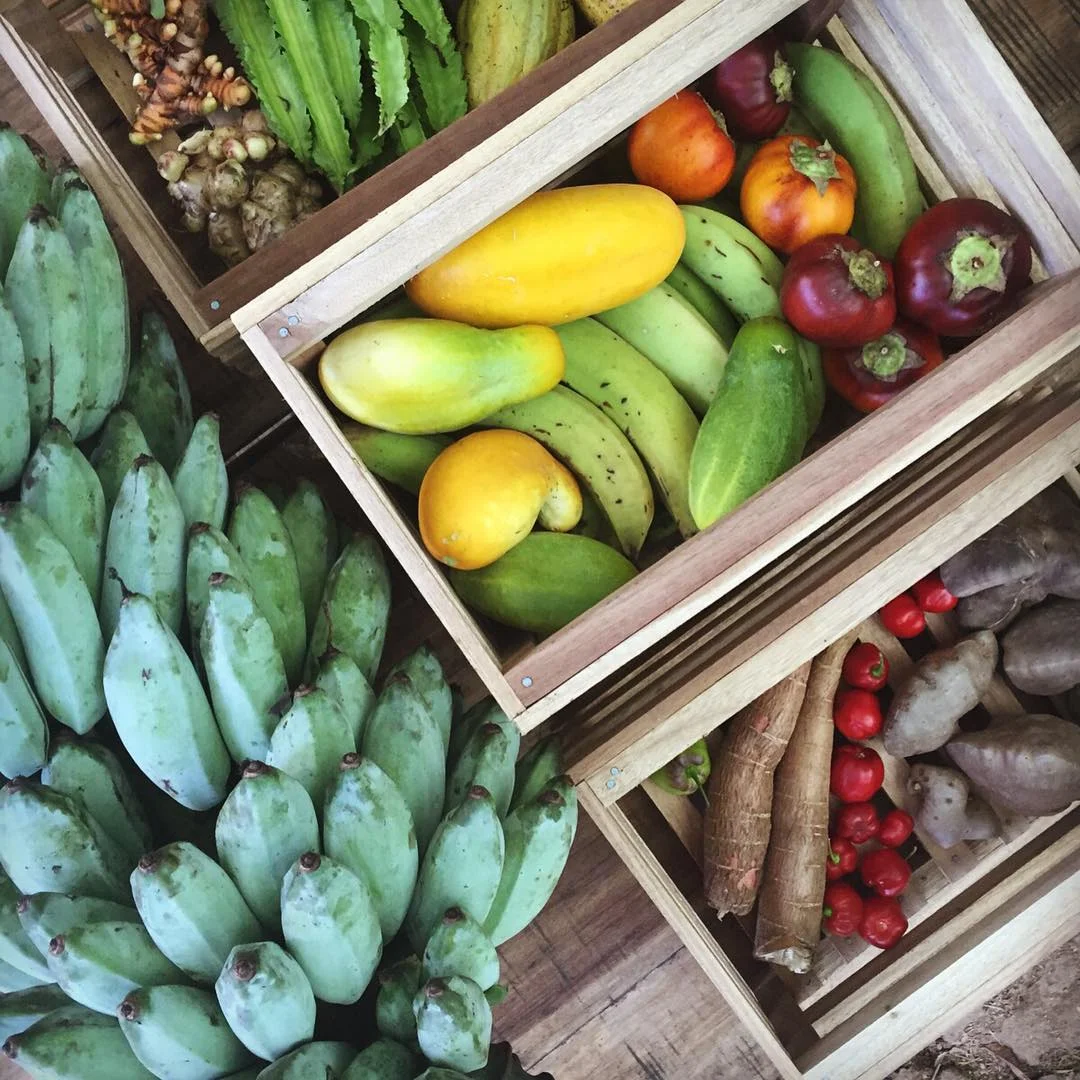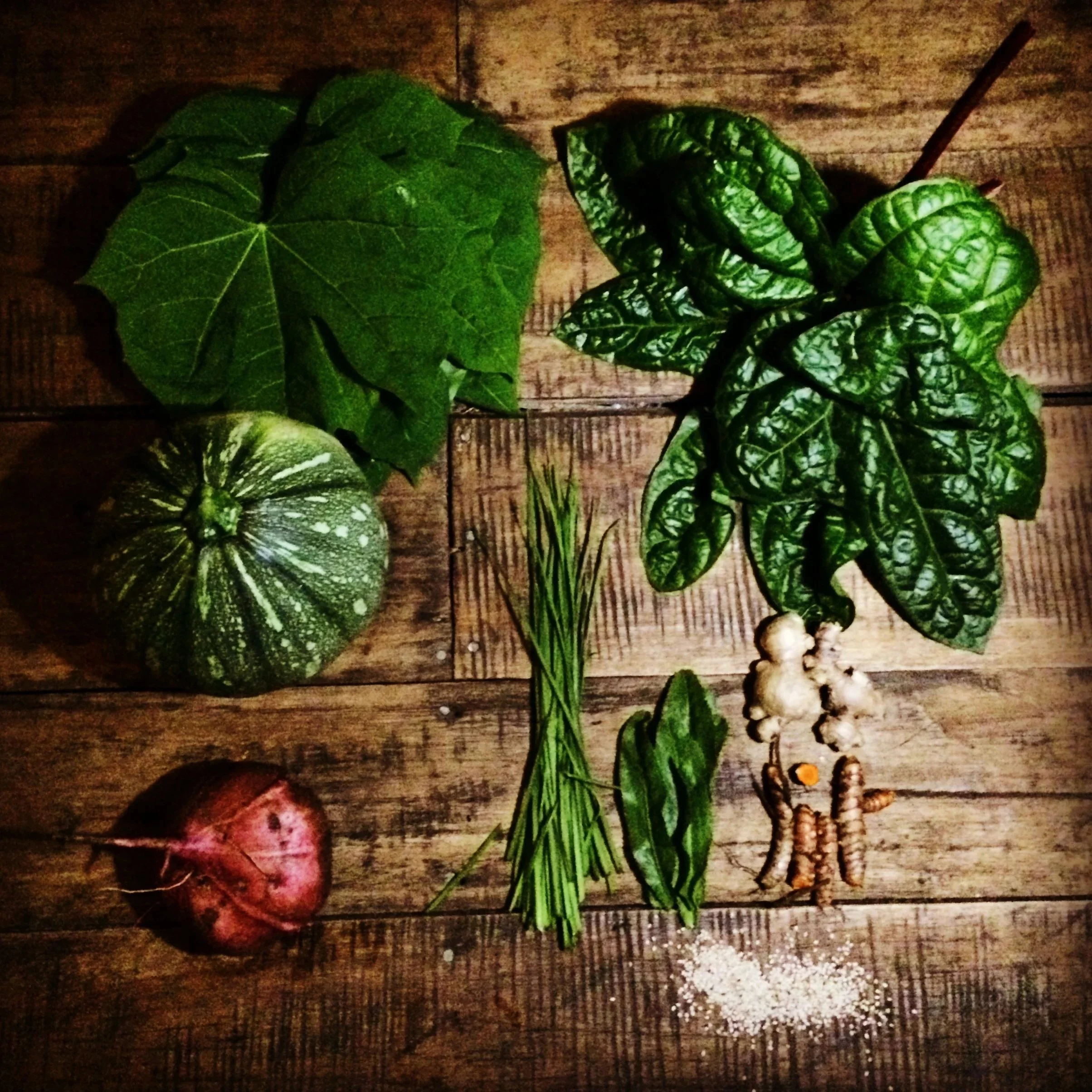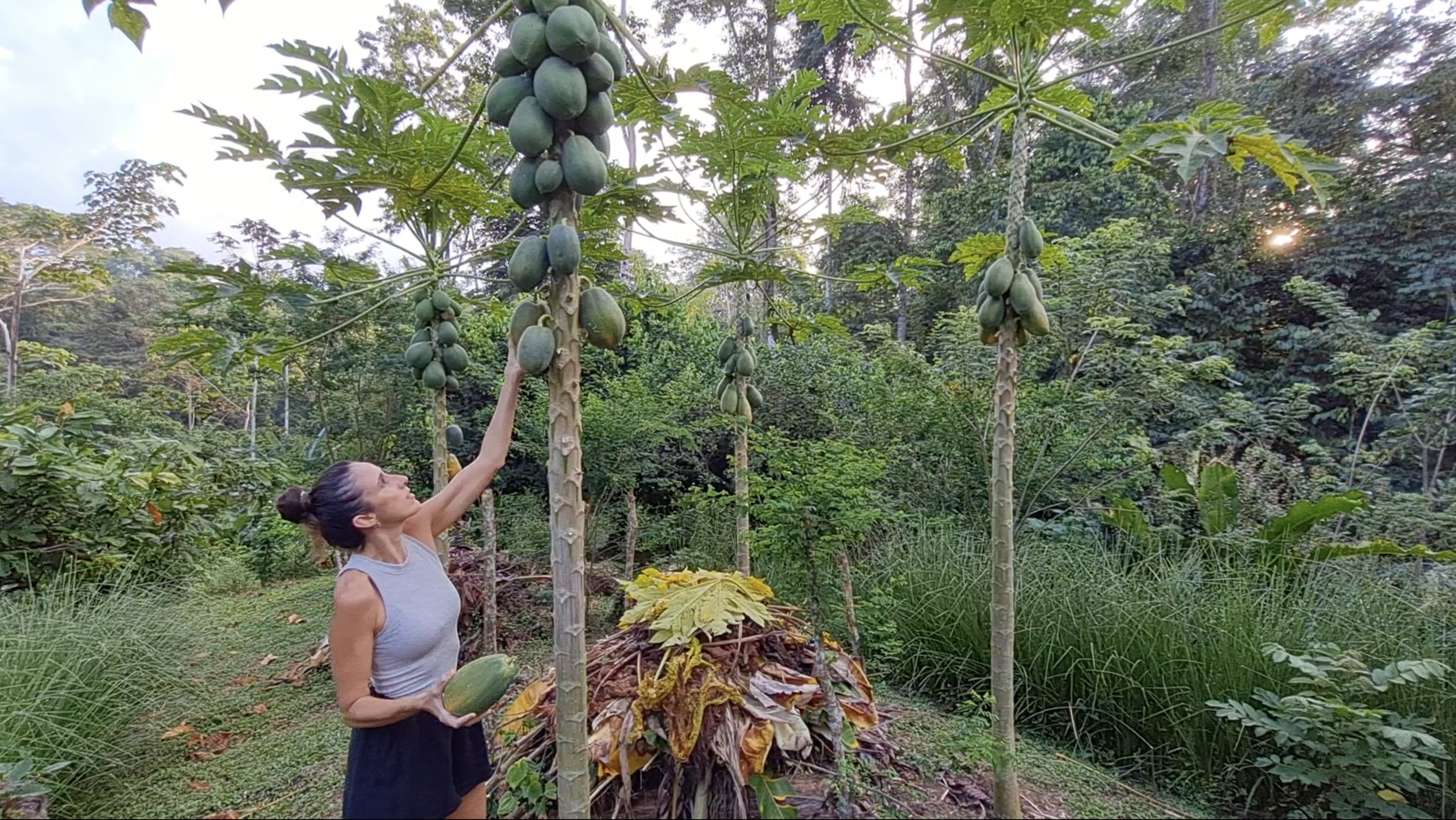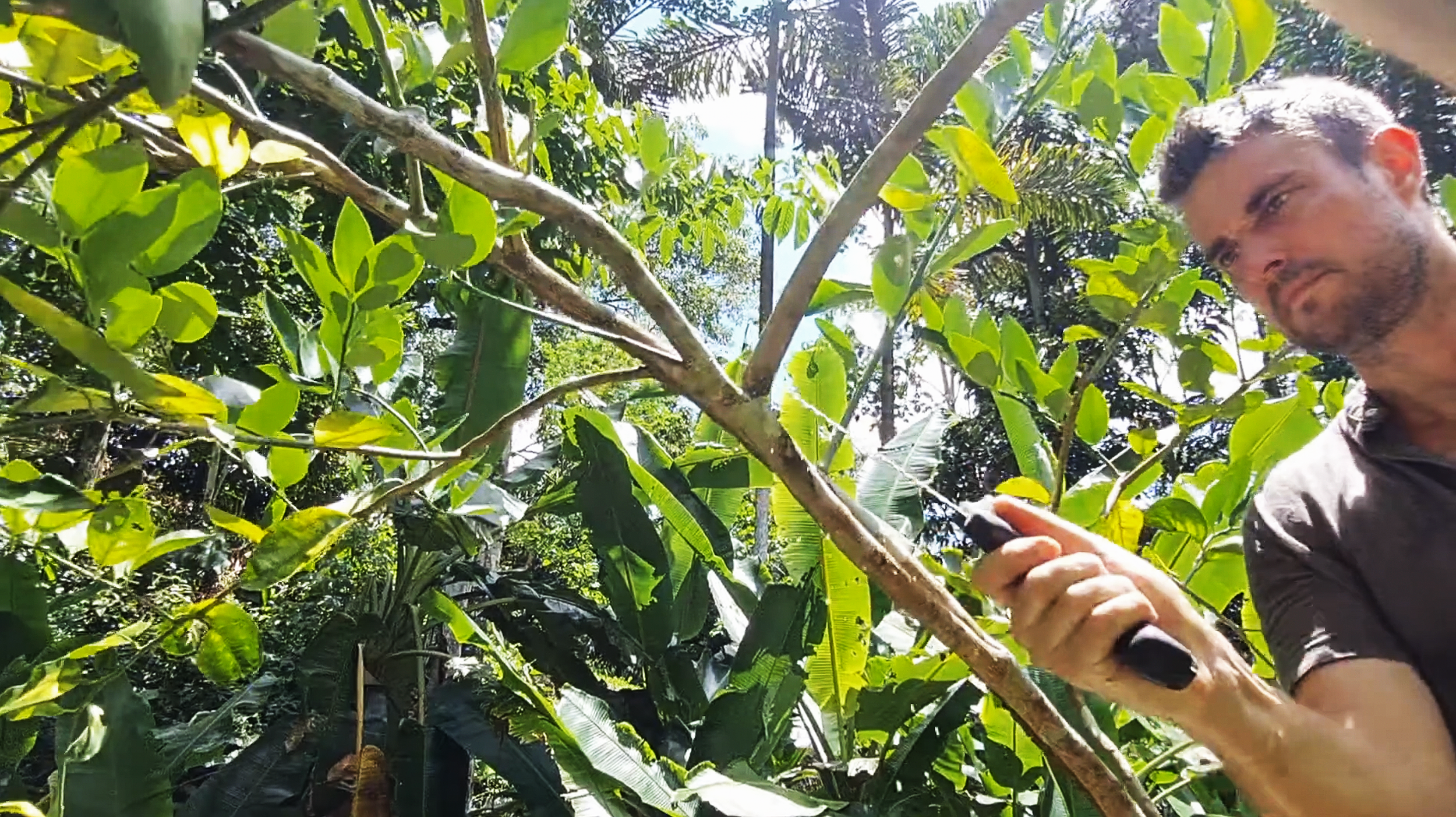How Much Land to Feed a Family: We Grow a Complete Diet on ½ Acre (2,000 m²) in the Tropics
Learn how we implemented a complete tropical homestead system on ½ acre (2,000 m²), and what it produces in real life.
This article is a real-world case study; for a step-by-step framework on how to design a tropical permaculture homestead as a complete system, see our guide to designing a self-sufficient tropical homestead.
→ See how we design the tropical vegetable garden inside this system.
A real-world tropical homestead on 2,000 m² (½ acre)
This ½-acre homestead is more than just a garden, it’s a working system that produces food, energy, and materials through integrated design.
Most people underestimate small land. In the tropics, the right crops make abundance inevitable.
On our 2,000 m² (½-acre) homestead in Costa Rica, we grow everything our family needs year-round. From calories and protein to cooking fats, fruits, and vitamins, this system shows what is possible with good planning and appropriate crop selection.
Our land is divided into simple, efficient zones:
Gardens for vegetables, roots, and grains
Food forest with fruit and nut trees
A small ecological pond for fish
A compost & biochar area for fertility
A small chicken coop for eggs and compost shredding
Everything is conveniently close to the house, easily accessible, manageable, and enjoyable to walk through every day.
The tropical staples that keep us fed
We focus on resilient perennials that thrive in the humid tropics with little maintenance.
Just 10 crops provide around 1.3 million calories per year, covering more than 75% of our household energy needs.
These form the backbone of our tropical diet, providing calories, protein, and fat while requiring almost no external inputs once established.
What Our Tropical Food Forest Produces Each Year
This overview showcases what’s possible with effective tropical planning; the full breakdown, including climate adaptations and yield calculators, is part of our online course.
| Crop | Annual Yield (per plant) | Main Use & Notes |
|---|---|---|
| Breadfruit | 100–150 kg | Staple starch — the “potato tree.” We fry, roast, boil, or simmer it in coconut milk for a creamy purée. Long-lived, producing for decades. |
| Breadnut | 50 kg + | Our “bean tree.” Chestnut-flavored seeds rich in protein, comparable to legumes. Produces multiple crops per year. |
| Coconut | 50–70 nuts | Main source of oil, milk, and hydration. We press our own coconut oil for cooking breadfruit, plantains, and roots. |
| Avocado | 50–80 fruits | Healthy fats. Multiple varieties provide long harvests throughout the year. |
| Banana & Plantain | ≈ 60 kg (3 bunches) | Dessert, date, ice-cream, and classic plantains — fried green or caramelized when ripe. |
| Corn | 120 kg + | Staple grain for tortillas and porridge; nixtamalized for masa. |
| Beans | 40 kg + | Staple protein. |
| Adlai (Job’s Tears) | 40 kg + | Perennial grain with protein comparable to beans; cooked like rice or barley. |
| Papaya | 30–50 kg | Sweet, high-vitamin ripe fruits and versatile when green for salads and stews. |
| Rambutan | 60–100 kg | Abundant, juicy fruit; can be dried like dates. |
Breadfruit being prepared for fries
Cooked adlai
Red beans drying before storage
Our protein strategy
Protein is easy in the tropics if you combine the right plants.
We rely mainly on breadfruit, breadnut, adlai, beans, corn, and chaya, just these six crops supply roughly 70 % of our annual protein.
We also keep a few hens for eggs. They live in mobile forest-style coops where they can scratch, shred leaves, and turn compost. They eat insects and larvae from our food scraps, producing omega-3 and B12-rich eggs, as well as nitrogen-rich manure for the garden.
We also keep a small backyard fish pond using an ecological green-water system. Tilapia fish thrive on algae and high-protein leaves—no commercial feed needed— and it’s low input and provides a few fish meals each week.
Together with beans, breadnut, and adlai, these crops meet our protein needs sustainably, producing nearly twice the recommended daily requirement.
Protein balance is one of the biggest challenges in tropical systems. We cover full nutrient planning (for omnivore and vegetarian diets) inside the course, using real data from our homestead.
Hens cycle food waste, eat insects, and turn compost
Low-input tilapia pond
| Crop / Source | Protein (per 1 cup cooked) | Notes |
|---|---|---|
| Breadnut (Artocarpus camansi) | 15–17 g | “Bean tree” — chestnut-flavored seeds; same protein as beans. |
| Adlai / Job’s Tears (Coix lacryma-jobi) | 13–15 g | Perennial grain; equal to beans in protein per cup. |
| Beans (Common red or black) | 14–16 g | Staple legume protein; stores well for year-round use. |
| Chaya & Moringa (greens) | 5–6 g | Boiled leaves rich in iron, calcium, and plant protein. |
| Egg (free-range hen) | 6 g per egg | High b12 and omega-3 (DHA/EPA) when fed with insects. |
| Tilapia (green-water pond) | 20–22 g per 100 g fillet | Low-input fish protein; feeds on algae and high-protein leaves to increase Omega 3. |
Values are approximate per standard serving (1 cup cooked for plants, 1 egg, or 100 g fish). Data from USDA FoodData Central and FAO regional food composition tables for tropical crops (Adlai, Breadnut, Chaya).
Growing our own fats
Tropical homestead fats come from avocados and coconuts, easy to grow, long-lived, and endlessly useful.
Coconuts supply oil and milk for cooking; avocados add freshness to every meal.
We’ve experimented with cashew and macadamia, but found them labor-intensive and less consistent in our climate.
Harvesting avocados
Pressing coconuts for cooking oil supply
Greens and vegetables
Once our staples are set, the gardens supply freshness and nutrients.
We grow cherry tomatoes, cucumbers, sweet peppers, eggplants, tropical bunching onions, and green beans, plus hardy tropical greens like chaya, moringa, katuk, and cranberry hibiscus.
These leafy crops are nutrient-dense, resilient, and thrive in the humidity. Chaya and moringa alone provide abundant iron and plant protein, while hibiscus leaves add antioxidants, a tangy flavor, and color to meals.
They grow near the kitchen for quick harvests. With heavy mulch, they require little irrigation, even in dry months.
Our tropical vegetable garden is designed like a mini-forest garden with mulch, airflow, and constant fertility.
Harvesting swet potatos from the vegetable garden
Harvesting chaya with ginger (bellow) and cranberry hibiscus garlic vine and moringa in the background
Nutrients from the garden
Once the staples are secured, everything else is flavor, color, and nutrition.
Vitamin A: sweet potatoes, papaya, moringa, chaya
Vitamin C: guava, acerola, pineapple, sweet pepper
Calcium: adlai, beans, breadfruit, chaya, greens
Iron & Zinc: beans, adlai, cacao, coconut
Omega-3 (ALA): chaya, breadnut, beans, adlai
Together, these help keep our diet naturally balanced, with no supplements needed, except for vitamin B-12, which can be obtained from fish or eggs.
Fruit harvest
Veggie harvest
Greens harvest
The design behind it all
Our layout follows permaculture design principles: working with the sun, water, fertility, and human movement.
The vegetable garden is located near the house for daily harvests
Food forest builds its own fertility through Gliricidia, Tithonia, and perennial peanut
Greywater irrigates banana & papaya circles
Compost + biochar recycle all waste back to the soil
The system now maintains itself with only a few hours of weekly care, primarily consisting of pruning, harvesting, and composting.
Harvesting green papayas
Pruning citrus
What this means
Our ½-acre produces roughly:
2+ million calories per year
All our daily fruits and vegetables
A surplus of our protein & fats
A complete, balanced tropical diet
It’s not about growing everything perfectly; it’s about creating a living system that regenerates itself, saves money, and promotes our health.
What you’ll notice changing
You feel healthier and more energized. Freshly harvested food makes a difference you can feel.
Your grocery trips shrink. Stores become places just for occasional essentials.
Your meals transform. Flavor and nutrition improve, while effort decreases.
Your land gains purpose. A yard becomes a living classroom, pantry, and apothecary.
Waste turns into abundance. Scraps become compost → compost becomes soil → soil becomes food.
Growing food becomes a rhythm, not a chore. Nature works with you, not against you.
You regain your freedom and time. More space for loved ones, creativity, and what actually matters.
Learn More
Online Tropical Permaculture Design Course →
A complete step-by-step program with video lessons, written modules, design templates, and crop/area charts. Designed for tropical climates, the course allows students to study from anywhere and develop a homestead or regenerative project at their own pace.
Plant · Harvest · Cook Retreat — Costa Rica →
A week of cooking, gardening, and slow tropical living in the rainforest. Stay in a private cabin, enjoy farm-to-table meals, and learn simple regenerative skills with us at Finca Tierra.
7 days · 6 nights · Private cabin · Farm-to-table meals · Garden & cooking sessions
On-Site 2-Week Immersion — Costa Rica (72-hour Certificate) →
Wake up in a bamboo cabin surrounded by food forests & jungle in Costa Rica. Learn through real-world permaculture systems in the mornings and design regenerative landscapes in the afternoons — the 72-hour Permaculture Design Course (PDC) is all-inclusive, with accommodations, farm-to-table meals, and a field trip exploring indigenous cosmovision.
FAQ — Common questions
-
About 2,000 m² (½ acre), when designed for staples, protein, fats, and fruit, can supply a full diet and year-round food security for a small family in the humid tropics. Even smaller plots can produce a significant percentage of household food needs.
-
Fast vegetables can be harvested in the first 3 months, with quick fruits like papaya and banana producing within the first year. Most fruit trees begin bearing in 3–4 years.
-
Not necessarily—breadnut, adlai grain, beans, and the rest easily cover recommended protein needs. Tilapia or hens are optional add-ons.
-
We spend about 4–5 hours per week, for general maintenance and main harvests— likely similar to mowing and trimming a normal yard. Cooking and processing foods is more time-consuming. -
For the trees, we only water if necessary during the first year of establishment. The system sustains itself through mulch, compost, and living ground cover. Our soil is unusually poor compared to most of Costa Rica, and it was a depleted cattle pasture. We have added a small amount of minerals to correct extreme micronutrient deficiencies and pH imbalance.
Related reading
Tropical Food Forest Design: Best Trees & Support Species for Abundance
Tropical Vegetable Garden: How to Grow Abundantly in the Tropics
About the authors
Ian Macaulay is an artist, tropical permaculture designer, and educator specializing in food forests, regenerative homesteads, and tropical agroforestry.
Ana Gaspar A. is a Costa Rican lawyer and sustainability advocate passionate about indigenous cosmovision, bioregional community organisation, food sovereignty, and ecolegality.
Together, they founded Finca Tierra Permaculture Education Center, where they live off the grid, teach internationally certified Permaculture Design Courses, and develop replicable models for self-sufficient living in the tropics.
fincatierra@gmail.com

